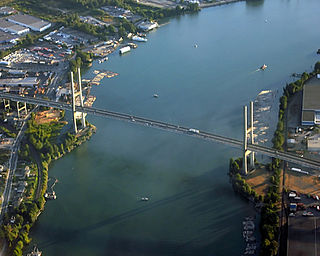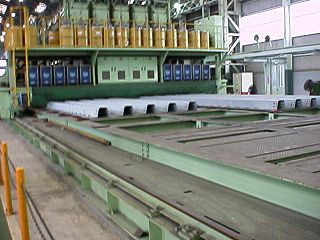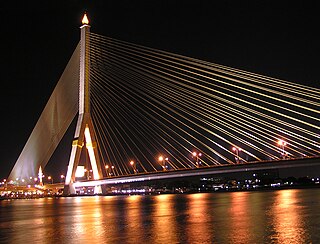Related Research Articles

A suspension bridge is a type of bridge in which the deck is hung below suspension cables on vertical suspenders. The first modern examples of this type of bridge were built in the early 1800s. Simple suspension bridges, which lack vertical suspenders, have a long history in many mountainous parts of the world.

A cable-stayed bridge has one or more towers, from which cables support the bridge deck. A distinctive feature are the cables or stays, which run directly from the tower to the deck, normally forming a fan-like pattern or a series of parallel lines. This is in contrast to the modern suspension bridge, where the cables supporting the deck are suspended vertically from the main cable, anchored at both ends of the bridge and running between the towers. The cable-stayed bridge is optimal for spans longer than cantilever bridges and shorter than suspension bridges. This is the range within which cantilever bridges would rapidly grow heavier, and suspension bridge cabling would be more costly.

The Lions Gate Bridge, opened in 1938 and officially known as the First Narrows Bridge, is a suspension bridge that crosses the first narrows of Burrard Inlet and connects the City of Vancouver, British Columbia, to the North Shore municipalities of the District of North Vancouver, the City of North Vancouver, and West Vancouver. The term "Lions Gate" refers to the Lions, a pair of mountain peaks north of Vancouver. Northbound traffic on the bridge heads in their general direction. A pair of cast concrete lions, designed by sculptor Charles Marega, were placed on either side of the south approach to the bridge in January 1939.

The Rio–Antirrio Bridge, officially the Charilaos Trikoupis Bridge, is one of the world's longest multi-span cable-stayed bridges and longest of the fully suspended type. It crosses the Gulf of Corinth near Patras, linking the town of Rio on the Peloponnese peninsula to Antirrio on mainland Greece by road. It opened one day before the Athens 2004 Summer Olympics, on 12 August 2004, and was used to transport the Olympic flame.

The Alex Fraser Bridge is a cable-stayed bridge over the Fraser River that connects Richmond and New Westminster with North Delta in Greater Vancouver, British Columbia. The bridge is named for Alex Fraser, a former British Columbia Minister of Transportation. The bridge was the longest cable-stayed bridge in the world when it opened on September 22, 1986, and was the longest in North America until the Arthur Ravenel Jr. Bridge, in the U.S. state of South Carolina opened in 2005.

The Angus L. Macdonald Bridge is a suspension bridge crossing Halifax Harbour in Nova Scotia, Canada; it opened on April 2, 1955.

The Strait of Messina Bridge is a planned 3.6-kilometre suspension bridge across the Strait of Messina, connecting Torre Faro in Sicily with Villa San Giovanni in the Italian Peninsula.

The A. Murray MacKay Bridge, known locally as "the new bridge", is a suspension bridge linking the Halifax Peninsula with Dartmouth, Nova Scotia, and opened on July 10, 1970. It is one of two suspension bridges crossing Halifax Harbour. Its counterpart, the Angus L. Macdonald Bridge, was completed in 1955. The bridge carries on average 52,000 vehicle crossings per day, and is part of Nova Scotia Highway 111.

The eastern span replacement of the San Francisco–Oakland Bay Bridge was a construction project to replace a seismically unsound portion of the Bay Bridge with a new self-anchored suspension bridge (SAS) and a pair of viaducts. The bridge is in the U.S. state of California and crosses the San Francisco Bay between Yerba Buena Island and Oakland. The span replacement took place between 2002 and 2013, and is the most expensive public works project in California history, with a final price tag of $6.5 billion, a 2,500% increase from the original estimate of $250 million, which was an initial estimate for a seismic retrofit of the span, not the full span replacement ultimately completed. Originally scheduled to open in 2007, several problems delayed the opening until September 2, 2013. With a width of 258.33 ft (78.74 m), comprising 10 general-purpose lanes, it is the world's widest bridge according to Guinness World Records.

Stonecutters Bridge is a high level cable-stayed bridge spanning the Rambler Channel in Hong Kong, connecting Nam Wan Kok, Tsing Yi to Stonecutters Island. The bridge deck was completed on 7 April 2009, and opened to traffic on 20 December that year. The bridge was the second-longest cable-stayed span in the world at the time of its completion.
A suspension bridge supports its structural load with cables, ropes, or chains anchored at each end. Cables on the earliest suspension bridges were anchored in the ground; some modern suspension bridges anchor the cables to the ends of the bridge itself. Earliest suspension bridges had no towers or piers but the majority of larger modern suspension bridges have them. All of the 14 longest bridges in the world are suspension bridges.

An orthotropic bridge or orthotropic deck is typically one whose fabricated deck consists of a structural steel deck plate stiffened either longitudinally with ribs or transversely, or in both directions. This allows the fabricated deck both to directly bear vehicular loads and to contribute to the bridge structure's overall load-bearing behaviour. The orthotropic deck may be integral with or supported on a grid of deck framing members, such as transverse floor beams and longitudinal girders. All these various choices for the stiffening elements, e.g., ribs, floor beams and main girders, can be interchanged, resulting in a great variety of orthotropic panels.

An extradosed bridge employs a structure that combines the main elements of both a prestressed box girder bridge and a cable-stayed bridge. The name comes from the word extrados, the exterior or upper curve of an arch, and refers to how the "stay cables" on an extradosed bridge are not considered as such in the design, but are instead treated as external prestressing tendons deviating upward from the deck. In this concept, they remain part of the main bridge superstructure.

The Bandra-Worli Sea Link is a 5.6 km long, 8-lane wide cable-stayed bridge that links Bandra in the Western Suburbs of Mumbai with Worli in South Mumbai. It is the longest sea bridge, as well as the 5th longest bridge in India after Mumbai Trans Harbour Link, Bhupen Hazarika Setu, Dibang River Bridge and Mahatma Gandhi Setu. It contains pre-stressed concrete-steel viaducts on either side. It was planned as a part of the proposed Western Freeway that would link the Western Suburbs to Nariman Point in Mumbai's main business district, but is now planned to become part of the Coastal Road to Kandivali.

The Rama VIII Bridge is a cable-stayed bridge crossing the Chao Phraya River in Bangkok, Thailand. It was built to alleviate traffic congestion on the nearby Phra Pinklao Bridge. Construction of the bridge took place from 1999 to 2002. The bridge was opened on 7 May 2002 and inaugurated on 20 September, the birth anniversary of the late King Ananda Mahidol, after whom it is named. The bridge has an asymmetrical design, with a single pylon in an inverted Y shape on the west bank of the river. Its eighty-four cables are arranged in pairs on the side of the main span and in a single row on the other. The bridge has a main span of 300 metres (980 ft), and was one of the world's largest asymmetrical cable-stayed bridges at the time of its completion.

The Rock Creek Canyon Bridge is a large, multi-span, steel truss bridge on the Crowsnest Highway over Rock Creek Canyon in British Columbia. Originally built in 1951, the structure was widened and strengthened in 1992. Carrying two lanes of vehicular traffic, the bridge is 286 metres long and stands 91 metres above Rock Creek.

The 1915 Çanakkale Bridge is a road suspension bridge in the province of Çanakkale in northwestern Turkey. Situated just south of the coastal towns of Lapseki and Gelibolu, the bridge spans the Dardanelles, about 10 km (6.2 mi) south of the Sea of Marmara. The bridge is the longest suspension bridge in the world—with a main span of 2,023 m, the bridge surpasses the Akashi Kaikyo Bridge (1998) in Japan by 32 m (105 ft).
The Harbor Bridge Project is the replacement of the existing through arch bridge that crosses the Corpus Christi Ship Channel, which serves the Port of Corpus Christi in Corpus Christi, Texas, with a modern cable-stayed bridge design. The route will connect with SH 286 at its southern terminus and US 181 on the north. Groundbreaking on construction took place on August 8, 2016 and was scheduled to be completed by the spring of 2020, but was extensively delayed due to engineering and design issues, and is tentatively planned to be completed in 2025.
References
- ↑ Buckland, Peter (May 2013) "Buckland & Taylor Ltd – 40 years" Canadian Civil Engineer pp. 23–25.
- ↑ Dorton, Roger A. Spanning the years: Recollections of six decades in bridge engineering. ISBN 978-0-9953282-0-4 Chap 9. "Buckland & Taylor Ltd. (1993 to 1999)". pp. 211–269.
- ↑ "Alex Fraser Bridge" PCL Construction
- ↑ Buckland, Peter G. & Brian D. Morgenstern. "Conversion of a suspension bridge into a cable-stayed bridge". Canadian Journal of Civil Engineering. 18, 273–281 (1991)
- 1 2 "Bridge retrofit a modern miracle". The Globe and Mail. 7 January 2002.
- ↑ Jane Armstrong. "Bridge retrofit a modern marvel" The Globe and Mail, Canada.
- ↑ Van Hampton, Tudor (2012). "Push comes to shove over the Ohio river". ENR: Engineering News-Record. 269 (3).
- ↑ Milton-Madison Bridge Project. "Construction". Archived from the original on 2010-12-06. Retrieved 24 September 2019.
- ↑ Zaha Hadid Architects. "Sheikh Zayed bridge" . Retrieved 13 May 2019.
- ↑ Peer, George A. (January 1999). "Two reasons to celebrate". Heavy Construction News. Vol. 43, no. 1.
- ↑ Julian, Jack (21 February 2015). "Macdonald bridge's Big Lift project in Halifax explained". CBC News . Retrieved 14 October 2015.
- ↑ Halifax Harbour Bridges "About The Big Lift", Retrieved on June 19, 2014